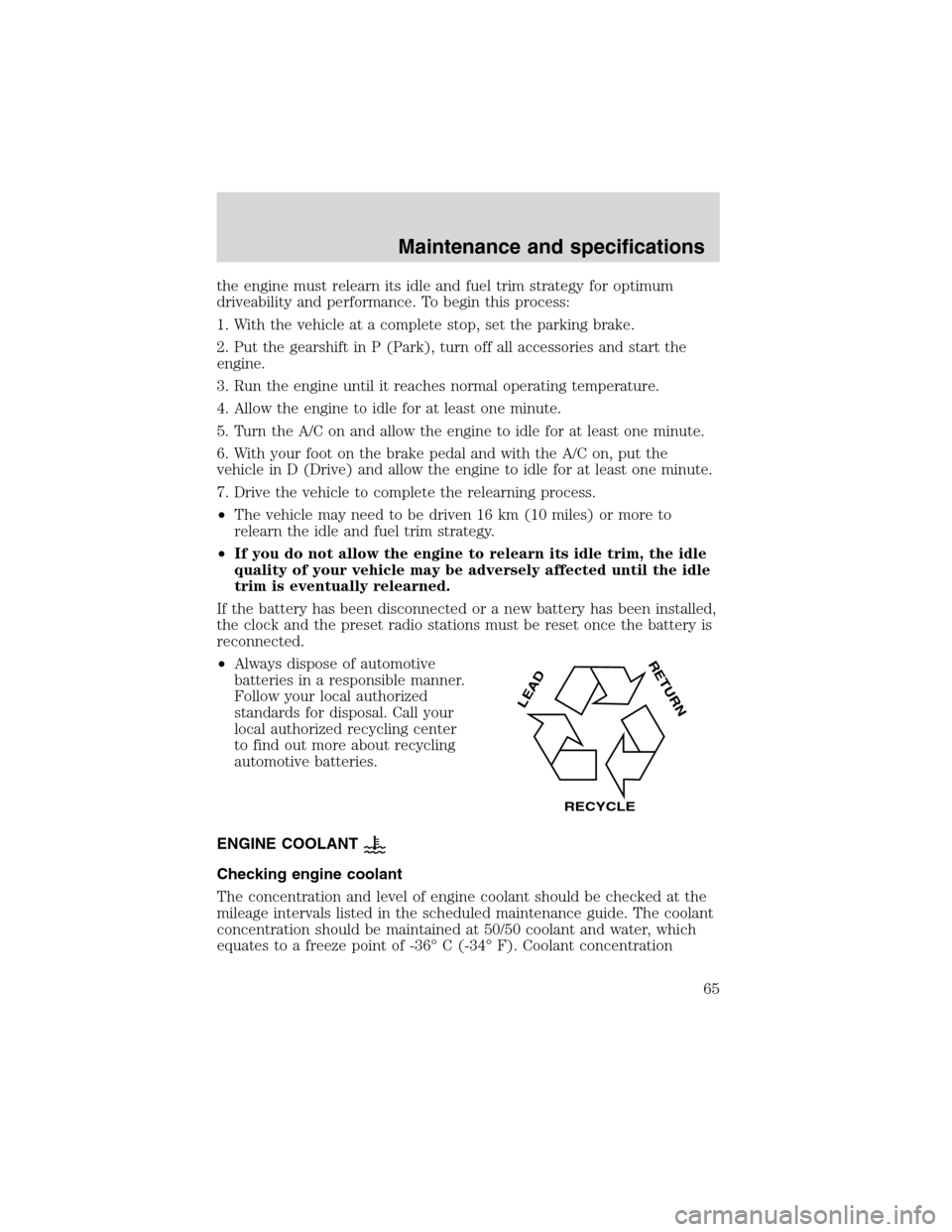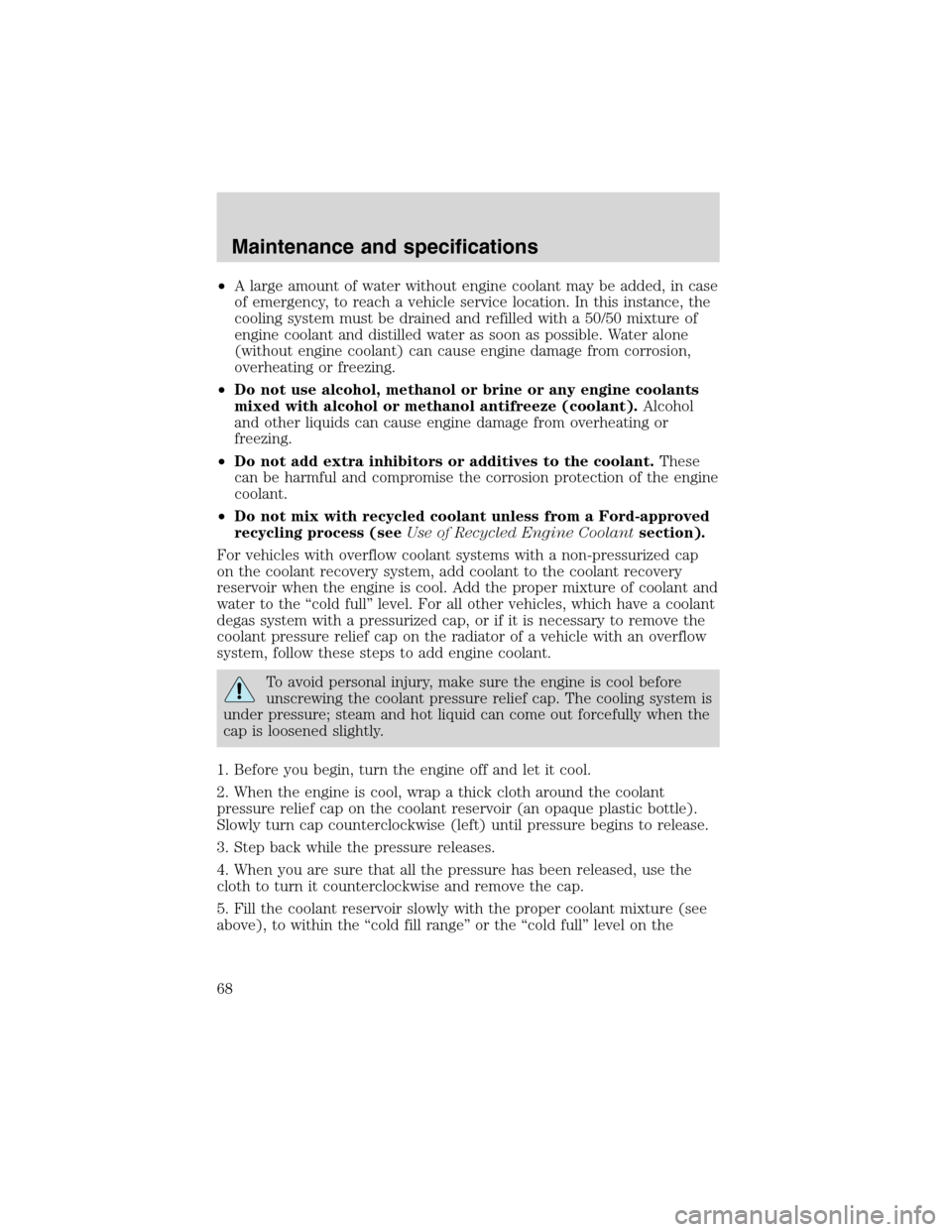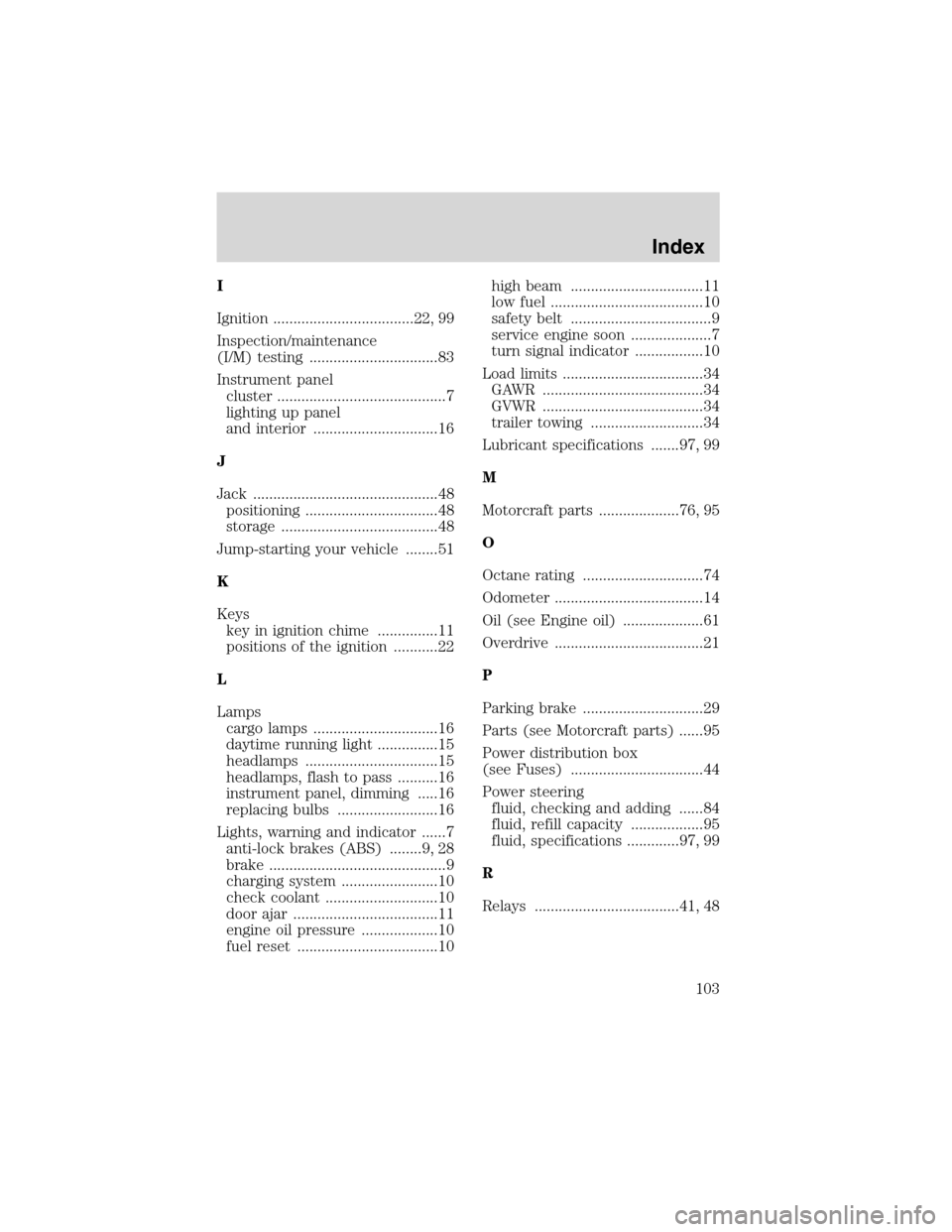2002 FORD F SERIES MOTORHOME AND COMMERCIAL CHASSIS lock
[x] Cancel search: lockPage 65 of 104

the engine must relearn its idle and fuel trim strategy for optimum
driveability and performance. To begin this process:
1. With the vehicle at a complete stop, set the parking brake.
2. Put the gearshift in P (Park), turn off all accessories and start the
engine.
3. Run the engine until it reaches normal operating temperature.
4. Allow the engine to idle for at least one minute.
5. Turn the A/C on and allow the engine to idle for at least one minute.
6. With your foot on the brake pedal and with the A/C on, put the
vehicle in D (Drive) and allow the engine to idle for at least one minute.
7. Drive the vehicle to complete the relearning process.
•The vehicle may need to be driven 16 km (10 miles) or more to
relearn the idle and fuel trim strategy.
•If you do not allow the engine to relearn its idle trim, the idle
quality of your vehicle may be adversely affected until the idle
trim is eventually relearned.
If the battery has been disconnected or a new battery has been installed,
the clock and the preset radio stations must be reset once the battery is
reconnected.
•Always dispose of automotive
batteries in a responsible manner.
Follow your local authorized
standards for disposal. Call your
local authorized recycling center
to find out more about recycling
automotive batteries.
ENGINE COOLANT
Checking engine coolant
The concentration and level of engine coolant should be checked at the
mileage intervals listed in the scheduled maintenance guide. The coolant
concentration should be maintained at 50/50 coolant and water, which
equates to a freeze point of -36° C (-34° F). Coolant concentration
LEAD
RETURN
RECYCLE
Maintenance and specifications
65
Page 68 of 104

•A large amount of water without engine coolant may be added, in case
of emergency, to reach a vehicle service location. In this instance, the
cooling system must be drained and refilled with a 50/50 mixture of
engine coolant and distilled water as soon as possible. Water alone
(without engine coolant) can cause engine damage from corrosion,
overheating or freezing.
•Do not use alcohol, methanol or brine or any engine coolants
mixed with alcohol or methanol antifreeze (coolant).Alcohol
and other liquids can cause engine damage from overheating or
freezing.
•Do not add extra inhibitors or additives to the coolant.These
can be harmful and compromise the corrosion protection of the engine
coolant.
•Do not mix with recycled coolant unless from a Ford-approved
recycling process (seeUse of Recycled Engine Coolantsection).
For vehicles with overflow coolant systems with a non-pressurized cap
on the coolant recovery system, add coolant to the coolant recovery
reservoir when the engine is cool. Add the proper mixture of coolant and
water to the “cold full” level. For all other vehicles, which have a coolant
degas system with a pressurized cap, or if it is necessary to remove the
coolant pressure relief cap on the radiator of a vehicle with an overflow
system, follow these steps to add engine coolant.
To avoid personal injury, make sure the engine is cool before
unscrewing the coolant pressure relief cap. The cooling system is
under pressure; steam and hot liquid can come out forcefully when the
cap is loosened slightly.
1. Before you begin, turn the engine off and let it cool.
2. When the engine is cool, wrap a thick cloth around the coolant
pressure relief cap on the coolant reservoir (an opaque plastic bottle).
Slowly turn cap counterclockwise (left) until pressure begins to release.
3. Step back while the pressure releases.
4. When you are sure that all the pressure has been released, use the
cloth to turn it counterclockwise and remove the cap.
5. Fill the coolant reservoir slowly with the proper coolant mixture (see
above), to within the “cold fill range” or the “cold full” level on the
Maintenance and specifications
68
Page 101 of 104

A
Air cleaner filter .............88–89, 95
Ambulance packages ....................4
Antifreeze
(see Engine coolant) ..................65
Anti-lock brake system
(see Brakes) ................................27
Automatic transmission
driving an automatic
overdrive ...................................31
fluid, adding ..............................86
fluid, checking ..........................86
fluid, refill capacities ................95
fluid, specification ....................99
Axle
lubricant specifications ......97, 99
refill capacities ..........................95
B
Battery .........................................63
acid, treating emergencies .......63
charging system
warning light .............................10
jumping a disabled battery ......51
maintenance-free ......................63
replacement, specifications .....95
servicing ....................................63
voltage gauge ............................13
Brakes ....................................26, 28
anti-lock .....................................27
anti-lock brake system
(ABS) warning light .............9, 28
brake warning light ....................9
fluid, checking and adding ......85
fluid, refill capacities ................95
fluid, specifications .............97, 99
lubricant specifications ......97, 99
shift interlock ............................30Break-in period .............................4
C
Capacities for refilling fluids ......95
Cleaning your vehicle
engine compartment ................58
exterior ......................................58
wheels ........................................58
Coolant
checking and adding ................65
refill capacities ....................69, 95
specifications ......................97, 99
Cruise control
(see Speed control) ....................17
D
Daytime running lamps
(see Lamps) ................................15
Dipstick
automatic transmission fluid ...86
engine oil ...................................61
Doors
door ajar warning .....................11
lubricant specifications ............97
Driveline universal joint and
slip yoke ......................................88
Driving under special
conditions
through water ...........................33
E
Emergencies, roadside
jump-starting ............................51
Emission control system ............82
Engine ..........................................99
Index
101
Page 102 of 104

check engine/
service engine soon light ...........7
cleaning .....................................58
coolant .......................................65
fail-safe coolant ........................70
idle speed control .....................63
lubrication specifications ...97, 99
refill capacities ..........................95
service points ............................60
starting after a collision ...........39
Engine block heater ...................25
Engine oil ....................................61
checking and adding ................61
dipstick ......................................61
filter, specifications ............62, 95
recommendations .....................62
refill capacities ..........................95
specifications ......................97, 99
Exhaust fumes ............................25
F
Fail safe cooling ..........................70
Fluid capacities ...........................95
Fuel ..............................................72
calculating fuel economy .........78
capacity .....................................95
choosing the right fuel .............74
comparisons with EPA fuel
economy estimates ...................81
detergent in fuel .......................75
filling your vehicle
with fuel ..............................72, 78
filter, specifications ............76, 95
fuel pump shut-off switch .......39
gauge .........................................13
improving fuel economy ..........78
low fuel warning light ..............10
octane rating .......................74, 99
quality ........................................75running out of fuel ...................75
safety information relating
to automotive fuels ..................72
Fuses ............................................41
G
Gas mileage
(see Fuel economy) ...................78
Gauges .........................................11
battery voltage gauge ...............13
engine coolant
temperature gauge ...................12
engine oil pressure gauge ........12
fuel gauge ..................................13
odometer ...................................14
speedometer .............................13
tachometer ................................14
trip odometer ............................14
GAWR (Gross Axle
Weight Rating) ............................34
calculating .................................35
definition ...................................34
driving with a heavy load ........34
location ......................................34
GVWR (Gross Vehicle
Weight Rating) ............................34
calculating ...........................34–35
definition ...................................34
driving with a heavy load ........34
location ......................................34
H
Hazard flashers ...........................39
Headlamps ...................................15
daytime running lights .............15
flash to pass ..............................16
high beam ...........................11, 15
turning on and off ....................15
warning chime ..........................11
Index
102
Page 103 of 104

I
Ignition ...................................22, 99
Inspection/maintenance
(I/M) testing ................................83
Instrument panel
cluster ..........................................7
lighting up panel
and interior ...............................16
J
Jack ..............................................48
positioning .................................48
storage .......................................48
Jump-starting your vehicle ........51
K
Keys
key in ignition chime ...............11
positions of the ignition ...........22
L
Lamps
cargo lamps ...............................16
daytime running light ...............15
headlamps .................................15
headlamps, flash to pass ..........16
instrument panel, dimming .....16
replacing bulbs .........................16
Lights, warning and indicator ......7
anti-lock brakes (ABS) ........9, 28
brake ............................................9
charging system ........................10
check coolant ............................10
door ajar ....................................11
engine oil pressure ...................10
fuel reset ...................................10high beam .................................11
low fuel ......................................10
safety belt ...................................9
service engine soon ....................7
turn signal indicator .................10
Load limits ...................................34
GAWR ........................................34
GVWR ........................................34
trailer towing ............................34
Lubricant specifications .......97, 99
M
Motorcraft parts ....................76, 95
O
Octane rating ..............................74
Odometer .....................................14
Oil (see Engine oil) ....................61
Overdrive .....................................21
P
Parking brake ..............................29
Parts (see Motorcraft parts) ......95
Power distribution box
(see Fuses) .................................44
Power steering
fluid, checking and adding ......84
fluid, refill capacity ..................95
fluid, specifications .............97, 99
R
Relays ....................................41, 48
Index
103